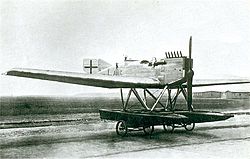Junkers J 11
| Junkers J 11 | |
|---|---|

|
|
| Type: | Maritime reconnaissance aircraft |
| Design country: | |
| Manufacturer: | |
| First flight: |
October 23, 1918 |
| Number of pieces: |
3 |
The Junkers J 11 aircraft is a single-engine, two-seat, all - metal low- wing aircraft . The first flight took place on October 23, 1918 .
development
Based on the experience that had been made with the Junkers J 10 with regard to its insensitivity to weather , it was assumed that this type of machine would also be suitable for sea use. The J 11 is based directly on the J 10, but here two floats were mounted under the fuselage instead of a landing gear so that this type can be used as a maritime patrol aircraft. After minor modifications to the rudder and the radiator, the type convinced. In particular, the sea properties were viewed positively. Due to the near end of the war, however, only three copies were made.
The aircraft, military designation CLS I , was powered by a 136 kW (185 hp) Benz Bz IIIa , which allowed a top speed of 180 km / h. The main dimensions were slightly larger than the J 10.
Technical specifications
| Parameter | Data |
|---|---|
| crew | 2 |
| Wingspan | 12.75 m |
| length | 8.80 m |
| height | 3.22 m |
| Wing area | 26.60 m |
| Wing loading | 53.38 kg / m² |
| Power load | 10.44 kg / kW |
| Empty mass | 915 kg |
| Payload | 505 kg |
| Takeoff mass | 1420 kg |
| drive | a water-cooled six - cylinder in - line engine Benz Bz IIIa |
| rated capacity | 185 hp (136 kW) at 1400 rpm |
| Top speed | 180 km / h |
| Marching speed | 165 km / h |
| Climb performance | 3.0 m / s |
| Summit height | 5000 m |
| Range | 750 km |
See also
literature
- Günter Schmitt: Junkers and his planes . Transpress, Berlin 1986, ISBN 3-344-00192-2 .
Web links
Individual evidence
- ^ Günter Schmitt: Junkers. Illustrated atlas of all aircraft types 1910–1945 . Transpress, Berlin 1990, ISBN 3-613-01339-8 , pp. 204/205 .
